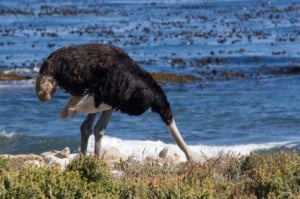In recent weeks we have seen the publishing by the State Government of its ‘reef facts’ website coordinated with a media blitz and TV ads by the Queensland Resources Council and an ‘Australians for coal’ website published by the Minerals Council of Australia. This spin campaign is misrepresenting the ‘facts’ and is a blatant attempt to divert attention away from the potential environmental harm of proposed port expansions and associated dredging programs along the Queensland coast, including Cairns port.
This looks a lot like taxpayers dollars being used to support an industry agenda using incomplete and misleading information.
The key argument of the campaign is summarised in this excerpt from an ABC story:
QRC chief executive Michael Roche says the QRC’s campaign draws on findings from Australian Institute of Marine Science (AIMS) research. The ads highlight scientific research that suggests natural phenomenon like storms and the crown-of-thorns starfish are contributing to coral losses. “It was time to encourage Australians to find out for themselves the true facts about the health of the Great Barrier Reef and what are the true pressures on the Great Barrier Reef,” he said.
The scientific research referred to here is the 2012 paper entitled “The 27-year decline of coral cover on the Great Barrier Reef and its causes”.
What the spin campaign fails to acknowledge is that the opening paragraph of this paper points out that major risk factors for coral reefs include dredging and coastal development (such as ports). This paper looks at three and only three ‘disturbance’ causes of coral damage –cyclones, coral bleaching and crown of thorns starfish (COTS) predation, but does also discuss the underlying causes of increased COTS outbreaks and reduced coral resilience/recovery including poor water quality. Poor water quality causes include increased sediment, nutrient and toxin loads reaching the reef – dredging suspends sediments, can release nutrients and can release toxins into the reef environment.
Unprecedented amounts of proposed dredging in Queensland ports (up to 80 million cubic metres of dredging planned in the Reef’s waters from Gladstone to Cairns), and the proposed increase in shipping, is an emerging threat that is only more recently receiving scientific attention. The lack of historical research in this area has led to the QRC making the statement “Neither an increase in shipping traffic nor port dredging has been scientifically recorded as contributing to coral cover loss or a historical decline in the environmental health of the GBR”.
To dismiss these threats is to dismiss the opinion of most scientists including the more than 150 scientists from 33 respected scientific institutions who in June 2013 signed the ‘Declaration by concerned scientists on industrial development of the Great Barrier Reef coast’. The scientists refer to the exact same research as the spin campaign (the AIMS 2012 paper) and other research before going on to state:
“As scientists, we therefore are concerned about the additional pressures that will be exerted by expansion of coastal ports and industrial development accompanied by a projected near-doubling in shipping, major coastal reclamation works, large-scale seabed dredging and dredge spoil disposal – all either immediately adjacent to, or within the Great Barrier Reef World Heritage Area.”
Clearly the Industry campaign and the Government ‘reef facts’ website are not giving us the whole picture…
Find out more about the risks of dredging for Cairns Port (Trinity Inlet) here.



